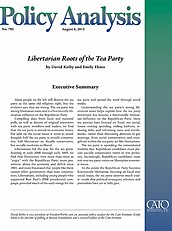Many people on the left still dismiss the tea party as the same old religious right, but the evidence says they are wrong. The tea party has strong libertarian roots and is a functionally libertarian influence on the Republican Party.
Compiling data from local and national polls, as well as dozens of original interviews with tea party members and leaders, we find that the tea party is united on economic issues, but split on the social issues it tends to avoid. Roughly half the tea party is socially conservative, half libertarian — or, fiscally conservative, but socially moderate to liberal.
Libertarians led the way for the tea party. Starting in early 2008 through early 2009, we find that libertarians were more than twice as “angry” with the Republican Party, more pessimistic about the economy and deficit since 2001, and more frustrated that people like them cannot affect government than were conservatives. Libertarians, including young people who supported Ron Paul’s 2008 presidential campaign, provided much of the early energy for the tea party and spread the word through social media.
Understanding the tea party’s strong libertarian roots helps explain how the tea party movement has become a functionally libertarian influence on the Republican Party. Most tea partiers have focused on fiscal, not social, issues — cutting spending, ending bailouts, reducing debt, and reforming taxes and entitlements — rather than discussing abortion or gay marriage. Even social conservatives and evangelicals within the tea party act like libertarians. The tea party is upending the conventional wisdom that Republican candidates must placate socially conservative voters to win primaries.
Increasingly, Republican candidates must win over tea party voters on libertarian economic issues.
To the extent the Republican Party becomes functionally libertarian, focusing on fiscal over social issues, the tea party deserves much credit — credit that political strategists, scholars, and journalists have yet to fully give.

This work is licensed under a Creative Commons Attribution-NonCommercial-ShareAlike 4.0 International License.


